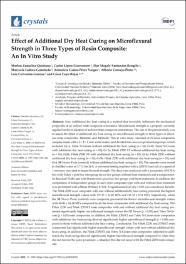Mostrar el registro sencillo del ítem
Effect of Additional Dry Heat Curing on Microflexural Strength in Three Types of Resin Composite: An In Vitro Study
| dc.contributor.author | Cayo Rojas, César Félix | |
| dc.contributor.author | Zamalloa-Quintana, Marlon | |
| dc.contributor.author | López-Gurreonero, Carlos | |
| dc.contributor.author | Santander-Rengifo, Flor Magaly | |
| dc.contributor.author | Ladera-Castañeda, Marysela | |
| dc.contributor.author | Castro-Pérez Vargas, Antonieta | |
| dc.contributor.author | Cornejo-Pinto, Alberto | |
| dc.contributor.author | Cervantes-Ganoza, Luis | |
| dc.date.accessioned | 2022-08-11T20:09:59Z | |
| dc.date.available | 2022-08-11T20:09:59Z | |
| dc.date.issued | 2022-07-27 | |
| dc.identifier.uri | https://hdl.handle.net/20.500.14308/3854 | |
| dc.description.abstract | Aim: Additional dry heat curing is a method that favorably influences the mechanical properties of an indirect resin composite restoration. Microflexural strength is a property currently applied for the evaluation of indirect resin composite restorations. The aim of the present study was to assess the effect of additional dry heat curing on microflexural strength in three types of directuse resin composites. Materials and Methods: This in vitro study consisted of 70 resin composites samples made with a 6 × 2 × 1 mm metal matrix and divided into seven experimental groups, which included Gr1a: Tetric N-Ceram without additional dry heat curing (n = 10); Gr1b: Tetric N-Ceram with additional dry heat curing (n = 10); Gr 2a: Filtek Z350 XT without additional dry heat curing (n = 10); Gr2b: Filtek Z350 XT with additional dry heat curing (n = 10); Gr3a: Filtek Z250 without additional dry heat curing (n = 10); Gr3b: Filtek Z250 with additional dry heat curing (n = 10); and Gr4: SR Nexco Paste (control) without additional dry heat curing (n = 10). The samples were stored in distilled water at 37 °C for 24 h. A universal testing machine with a 2000 N load cell at a speed of 1 mm/min was used to assess flexural strength. The data were analyzed with a parametric ANOVA test with Tukey’s post hoc intergroup factor (for groups without heat treatment) and a nonparametric Kruskall Wallis test with Bonferroni’s post hoc (for groups with heat treatment). In addition, the comparison of independent groups in each resin composite type with and without heat treatment was performed with a Mann Whitney U test. A significance level of p < 0.05 was considered. Results: The Filtek Z250 resin composite with and without additional dry heat curing presented the highest microflexural strength values with 137.27 ± 24.43 MPa and 121.32 ± 9.74 MPa, respectively, while the SR Nexco Paste (control) resin composite presented the lowest microflexural strength values with 86.06 ± 14.34 MPa compared to all the resin composites with additional dry heat curing. The Filtek Z250 and Filtek Z350XT resin composites with and without additional dry heat curing presented significantly higher microflexural strength versus the SR Nexco (p < 0.05) and Tetric N-Ceram (p < 0.05) resin composites. In addition, the Filtek Z350XT and Tetric N-Ceram resin composites with additional dry heat curing showed significantly higher microflexural strength (p < 0.05) compared to those without additional dry heat curing. Conclusions: The Filtek Z250 and Z350XT resin composites had significantly higher microflexural strength values with and without additional dry heat curing. In addition, the Filtek Z350XT and Tetric N-Ceram resin composites subjected to additional dry heat curing showed significantly higher microflexural strength compared to when they did not receive the same procedure, a situation that did not occur with the Filtek Z250 resin composite. | es_PE |
| dc.description.uri | Trabajo de investigacion | es_PE |
| dc.format | application/pdf | es_PE |
| dc.language.iso | en | es_PE |
| dc.publisher | MDPI. Revista Crystals | es_PE |
| dc.relation | MDPI. Revista Crystals | es_PE |
| dc.rights | info:eu-repo/semantics/openAccess | es_PE |
| dc.rights | Attribution-NonCommercial-NoDerivs 3.0 United States | * |
| dc.rights.uri | http://creativecommons.org/licenses/by-nc-nd/3.0/us/ | * |
| dc.source | Universidad Privada San Juan Bautista | es_PE |
| dc.source | Repositorio institucional - UPSJB | es_PE |
| dc.subject | Compuesto de resina | es_PE |
| dc.subject | Resistencia a la microflexión | es_PE |
| dc.subject | Odontología | es_PE |
| dc.subject | Polimerización complementaria | es_PE |
| dc.subject | Propiedades mecánicas | es_PE |
| dc.subject | Tratamiento térmico | es_PE |
| dc.title | Effect of Additional Dry Heat Curing on Microflexural Strength in Three Types of Resin Composite: An In Vitro Study | es_PE |
| dc.type | info:eu-repo/semantics/article | es_PE |
| dc.subject.ocde | https://purl.org/pe-repo/ocde/ford#3.02.14 | es_PE |
| dc.publisher.country | CH | es_PE |
| dc.date.embargoEnd | 2022-08-11 | |
| dc.type.version | info:eu-repo/semantics/publishedVersion | es_PE |



